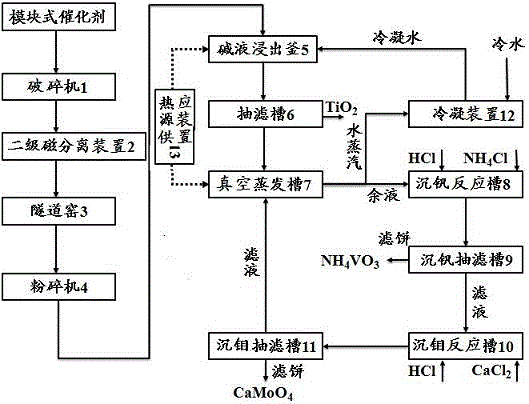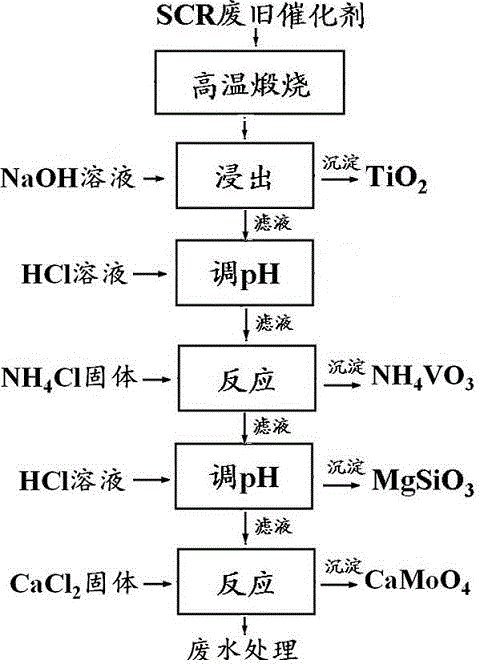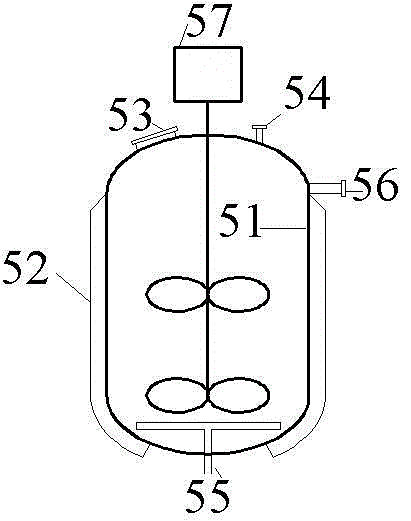Continuous recovery device and continuous recovery process of vanadium, molybdenum and titanium in SCR (selective catalytic reduction) waste catalyst
A waste catalyst and recycling device technology, applied in the field of solid waste recycling, can solve the problems of unfavorable large-scale application, harsh recycling conditions, and high operating costs, and achieve the effects of low recycling costs, easy conditions, and reduced operating costs.
- Summary
- Abstract
- Description
- Claims
- Application Information
AI Technical Summary
Problems solved by technology
Method used
Image
Examples
Embodiment 1
[0040] Such as figure 1 with figure 2 As shown, in this embodiment, a comprehensive recovery process and device for recovering V, Mo and Ti in spent SCR catalysts by alkaline leaching are carried out according to the following steps.
[0041] The flat-plate waste flue gas denitrification catalyst is physically crushed by the crusher to obtain steel mesh, iron filings and catalyst powder, which enters the secondary magnetic separation device through the conveyor belt to separate the steel mesh and iron filings, and the remaining catalyst powder enters the tunnel kiln at 850°C Calcination was continued for 4 h, and the obtained sintered agglomerate was sent into a pulverizer through a conveyor belt to be pulverized to more than 100 mesh, and then the powder was put into a reaction kettle containing a hot NaOH solution with a concentration of 20 wt% (relative to the weight of the spent catalyst) at a temperature of 80-90 °C , the bottom of the reactor is equipped with an aerat...
Embodiment 2
[0047] Such as figure 1 with figure 2 As shown, in this embodiment, a comprehensive recovery process and device for recovering V, Mo and Ti in spent SCR catalysts by alkaline leaching are carried out according to the following steps.
[0048] The flat-plate waste flue gas denitrification catalyst is physically crushed by the crusher to obtain steel mesh, iron filings and catalyst powder, which enters the secondary magnetic separation device through the conveyor belt to separate the steel mesh and iron filings, and the remaining catalyst powder enters the tunnel kiln at 750°C Continuous calcination for 4 h, the obtained sintered agglomerate was sent into the pulverizer through the conveyor belt and crushed to more than 100 mesh, and then the powder entered the reactor containing hot NaOH solution with a temperature of about 85 °C and a concentration of 20 wt% (relative to the weight of the spent catalyst). There is an aeration device at the bottom of the reactor, so that the...
Embodiment 3
[0055] Such as figure 1 with figure 2 As shown, in this embodiment, a comprehensive recovery process and device for recovering V, Mo and Ti in spent SCR catalysts by alkaline leaching are carried out according to the following steps.
[0056] The flat-plate waste flue gas denitrification catalyst is physically crushed by the crusher to obtain steel mesh, iron filings and catalyst powder, which enters the secondary magnetic separation device through the conveyor belt to separate the steel mesh and iron filings, and the remaining catalyst powder enters the tunnel kiln at 750°C Calcination was continued for 4 h, and the obtained sintered agglomerate was sent into a pulverizer through a conveyor belt to be pulverized to a size above 100 mesh, and then the powder was put into a reaction kettle containing a hot NaOH solution with a temperature of about 85 °C and a concentration of 30 wt% (relative to the weight of the spent catalyst). There is an aeration device at the bottom of ...
PUM
 Login to View More
Login to View More Abstract
Description
Claims
Application Information
 Login to View More
Login to View More - R&D
- Intellectual Property
- Life Sciences
- Materials
- Tech Scout
- Unparalleled Data Quality
- Higher Quality Content
- 60% Fewer Hallucinations
Browse by: Latest US Patents, China's latest patents, Technical Efficacy Thesaurus, Application Domain, Technology Topic, Popular Technical Reports.
© 2025 PatSnap. All rights reserved.Legal|Privacy policy|Modern Slavery Act Transparency Statement|Sitemap|About US| Contact US: help@patsnap.com



